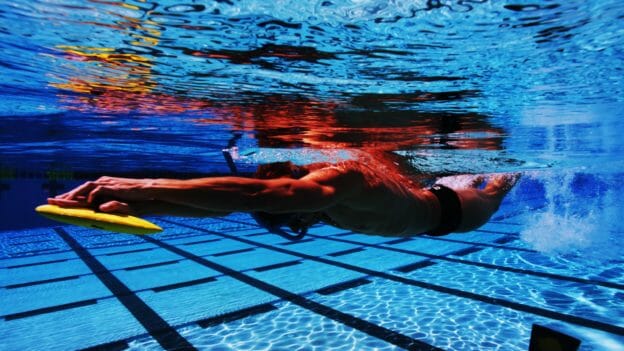How to Increase the Speed of Your Freestyle & Dolphin Kick
Part I: Getting the Motion Right
The amount of propulsion generated by the kick is arguably the most important difference among fast and not-so-fast swimmers. While the motions involved in the propulsion for freestyle, butterfly and backstroke kicks are similar, the breaststroke kick requires an entirely different set of physical attributes. For now, we will focus on freestyle or flutter kick.
As with the pull, the propulsion generated by the kick depends on the amount of surface area of the foot and the speed of that surface pushing backward (relative to the water). Unlike the pull, where the water in front of the hand moving backward is relatively still, the flow dynamics behind the swimmer (vortices) contribute significantly to the amount of propulsion generated by the foot.
There are three articulations involved in the freestyle kick; the hip, the knee and the ankle. To kick fast, they all need to be just right. As with the pulling motion, the ideal kicking motion must reach a compromise between the propulsive forces and the frontal drag forces.
The saying ‘bend but don’t break’ could not apply more appropriately than with the kicking motion. Having plantar flexibility of the ankle is the single most important physical attribute of a fast kicker. With greater plantar flexibility of the ankle, less knee bend is required to get the same amount of surface area of the top of the foot pushing backward. Some knee bend is required in all fast freestyle kicking, but once the bend of the knee passes around 60 degrees, the system breaks down. The drag coefficient increases dramatically and the swimmer decelerates quickly. A strong kicker with plantar flexibility knows exactly how much to bend the knee on each kick, before snapping the foot backward. A poor kicker with little plantar flexibility will often bend the knee well past 60 degrees in order to get more foot surface area to push backward. In so doing, he nearly comes to a screeching halt. The increase in propulsion he may get from over bending the knee will not offset the deceleration caused by the frontal drag from the knee bend. The resulting inefficient, varying speed does not conform to the law of inertia.
In order to reach the optimal knee bend for maximal kicking speed in freestyle and dolphin, the foot must come out of the water during the up kick. Swimmers with poor plantar flexibility tend to bring the foot too far out of the water. With great freestyle kickers at maximum effort, one sees a virtual boil of water formed behind the swimmer from the continuous hard motion of the foot in both directions. For more on the dynamics of the kick and vortices the foot can create read this Aqua Note.
Yours in Swimming,
Gary Sr.
Read Part II: Kick Faster in Freestyle and Dolphin Kick
Read Part III: Two Important Nuances of a Great Kicker
Read Part IV: Five Ways to Kick Faster in the Pool

